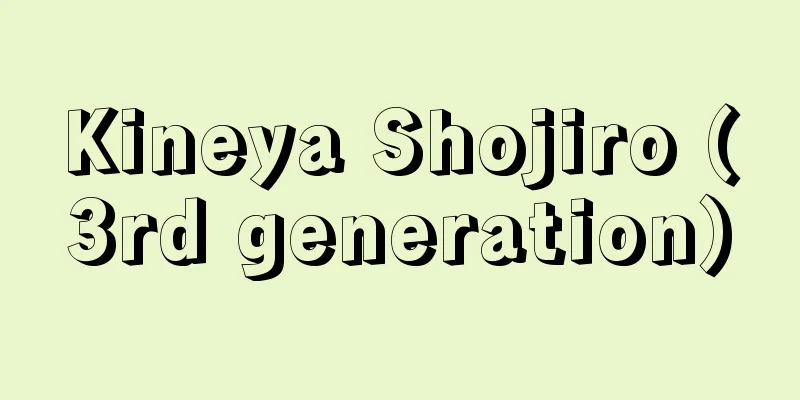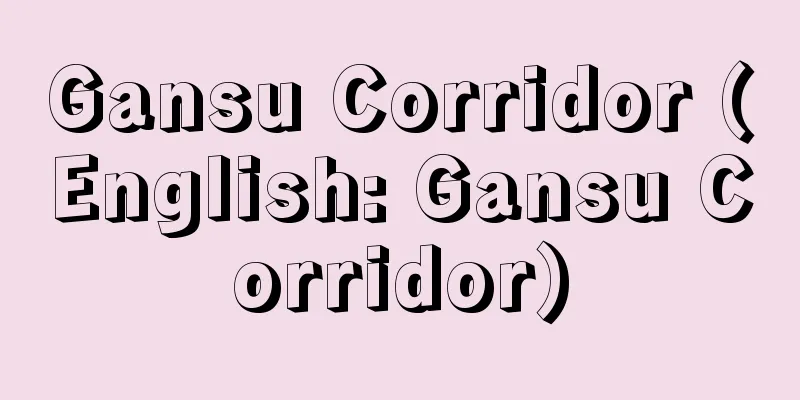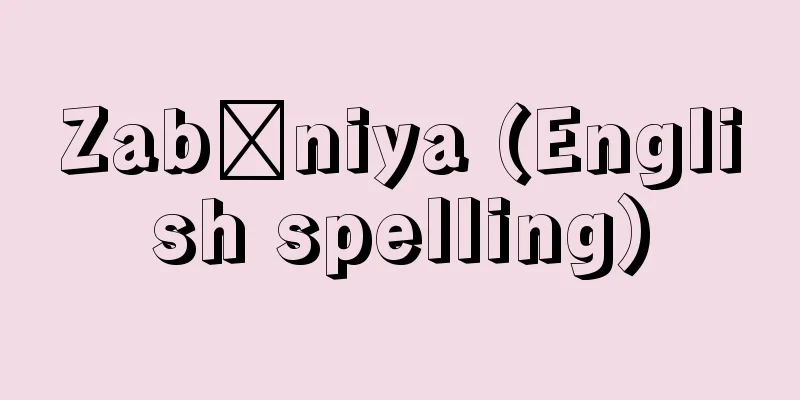Kineya Shojiro (3rd generation)

|
...Lyrics by Fukuchi Ochi. Music by Kineya Shojiro III. Choreography by Ichikawa Danjuro IX and Fujima Kan'emon II. From "Kishi no Yanagi"...The title of a Nagauta song. Lyrics by Kineya Umehiko, music by Kineya Shojiro III. A nagauta-style song in the style of a tanuta. It was first performed in June 1873 at a rented venue in eastern Ryogoku, Tokyo. It is a light, bright and stylish composition that depicts the summer scenery along the banks of the Sumida River from Yanagibashi to Ryogoku. There are two theories about the origin of the song. One is that it is a celebration of the daughter of the boat lodge Omi-ya, who nearly committed suicide with the son of a second-hand clothing store in the neighborhood, but was saved and reunited, and the other is that it is a celebration of the musical instrument player Kishida Izaemon's wish to marry a geisha from Omi-ya in Yanagibashi. A later version says that the title is a combination of the 'kishida' ('kish') and 'yanagi' ('yanagi') of Yanagibashi. From [Kizo's Garden]...The title of a Nagauta song. It was announced at the opening of Okayasu Kiyomo's stage in September 1859 (Ansei 6). The lyricist is unknown. It is said that the composer was Kineya Katsusaburo II for the first half of the song, and Kineya Shojiro III for the second half. The first half is a three-part verse influenced by the Yamada school koto piece Kogo no Kyoku (The Song of Kogo), and sings of the autumn atmosphere of Sagano, where Minamoto no Nakakuni searches for Kogo. It includes a long verse with koto tegoto, and the second half is a two-part verse, which is completely casual and describes the events of the brothels in reference to autumn grasses, and concludes with words to celebrate a good harvest. It is a masterpiece that sings of the autumn atmosphere. ... From "Genroku Flower Viewing Dance"...Kabuki dance. Nagauta. Original title: Genroku-style Flower Viewing Dance. First performed in June 1878 at the Shintomiza Theater in Tokyo by Ichikawa Danjuro IX, Onoe Kikugoro V, Ichikawa Sadanji I, Iwai Hanshiro VIII, Ichikawa Kodanji, and others. Lyrics by Takeshiba Hyōsuke. Music by Kineya Shojirō III. Choreography by Hanayagi Jūsuke I and others. A dance performed at a flower viewing party in the mountains of Ueno, depicting the customs of the Genroku period, including bathhouse girls, samurai, young men, town girls, slaves, and townspeople. The melody captures the glamorous Genroku-style mood in a two-stage performance, and the song is also famous abroad. [Nishigata Setsuko]... From 【Shōjō】…(1) Noh piece title. Fifth piece. Celebration piece. Author unknown. Shite plays a shojo. In the village of Yangzi in China, there was a filial sake seller (waki) named Kofu. A shojo living in the sea nearby came to his store, drank sake, danced and played around (〈Wataru-byoshi/Midare〉), and blessed Kofu by giving him a bottle of sake that never runs out, no matter how much it was filled with. The play has a unique rhythm with many changes in speed, and the dance does not use the usual sliding feet, but instead uses slipping feet, kicking feet, and gliding on tiptoes, showing the performers playing and playing on the water. … From "Sofuoraku (Sofuoraku)"…(1) The title of a Kyogen piece. Written as “Soro-raku.” Tarokaja Kyogen. Found in both the Okura and Izumi schools. The master suddenly decides to visit Ise Shrine, and sends Tarokaja to speak in an attempt to invite his uncle, who had previously promised to accompany him, as a formality. The uncle declines as it is a sudden matter, but Tarokaja, sensing that the master will accompany him, offers him some sake to celebrate the occasion. The drunken Kanja praises his uncle, complains about the master’s folly, and even receives a soro as a gift, returning home in high spirits. Tarokaja is late returning, so the master goes halfway to meet him and asks for his uncle’s reply, but he doesn’t get the point. … From the Chikuma River...The title of a Nagauta piece. First performed at the Shintomiza Theater in Tokyo in October 1879. Lyrics by Kawatake Mokuami. Music by Kineya Shojiro III. This is an Ozatsuma piece used in the scene in the Kaga Uprising kyogen play Kagamiyama Nishiki no Momijiba, in which Otsuki Kuranobu commands Torii Matasuke to kill the governor of Kaga. The piece is in the main tune, and begins with a description of the full-water Chikuma River, followed by the "ninja's accompaniment" in which Matasuke spies on the heroic water horse, but then the "first moon's accompaniment" begins, depicting the crowding of people and horses.... From "Tsuchigumo"...The title of a piece in Noh and Kabuki dance. (1) Noh Depending on the school, it can be written as either "Tsuchigumo" or "Tsuchigumo". The fifth piece. A demon piece. Author unknown. The shite is a demon god, the spirit of a tsuchigumo. A maid named Kocho (Tsure) returns to the mansion of Minamoto no Yorimitsu (Raiko) (Tsure) with medicine. Raiko is seriously ill and suffering. A suspicious monk (Maejite) appears and throws a spider web thread at Raiko, but is wounded by the tip of Raiko's sword and disappears. Hearing a noise, a lone warrior (Waki) rushes to the scene and quickly finds bloodstains. He decides to follow the trail and track down the monster's whereabouts. ... From "Nagauta"...A type of shamisen music. It was established as background music for Kabuki plays or as accompaniment to the dance, and is primarily song music with the shamisen as the main instrument, but there are also cases where it is an interlude that can stand alone as an instrumental piece, or where the song is omitted and only the shamisen is performed. Four instruments called "narimono" (musical instruments) - a taiko drum, an o-tsuzumi drum, a ko-tsuzumi drum, and a flute (also called shibyōshi) - are sometimes added, and various other background instruments are sometimes added behind the stage. In later times, it became independent of plays and dances and was also performed as music alone. ... From [Mochizuki]…(1) The title of a Noh piece. The fourth piece. A contemporary piece. Author unknown. The shite is Ozawa Gyobu Tomofusa. When Yasuda Shoji Tomoharu, a resident of Shinano Province, is murdered, his wife (Tsure) and son Hanawaka (Kokata) set out on a journey of exile. While staying at an inn called Kabutoya in Moriyama, Omi Province, they discover that the innkeeper is their former retainer, Ozawa Gyobu Tomofusa (Shite), and are overjoyed to be reunited. By chance, Mochizuki Akinaga (Waki), an enemy of the innkeeper, Yasuda Shoji, also happens to be staying there. … From "Autumn Leaves Viewing"…(1) The title of a Noh piece. The fifth piece. A demon piece. Written by Kanze Nobumitsu. The shite is a demon of Mount Togakushi. Taira no Koremochi (waki) goes deer hunting on Mount Togakushi in Shinano and sees a group of beautiful women (mae-jite and tsure) enjoying autumn leaves. Invited to join the banquet, Koremochi falls asleep while admiring the women's dance with a cup in hand (Kuse, Jo-no-mai (or Naka-no-mai), Kyu-no-mai). The woman is actually a demon, who watches Koremochi's sleep and disappears. … *Some of the terminology explanations that refer to "Kineya Masajiro (3rd generation)" are listed below. Source | Heibonsha World Encyclopedia 2nd Edition | Information |
|
…作詞福地桜痴。作曲3世杵屋(きねや)正治郎。振付9世市川団十郎,2世藤間勘右衛門。… 【岸の柳】より…長唄の曲名。杵屋(きねや)梅彦作詞,3世杵屋正次郎作曲。端唄風長唄。1873年6月に東京の東両国の貸席で初演。柳橋から両国にかけての隅田川河畔の夏の情景を軽く明るく粋に作曲。曲の由来には2説あり,船宿近江屋の娘が近所の古着屋の息子と心中しかけたが助けられ結ばれた祝いとも,また鳴物師岸田伊左衛門が思いかなって柳橋の近江屋の芸者と夫婦になった祝いとも言う。後説では岸田の岸と柳橋の柳とをとって題名にしたという。… 【喜三の庭】より…長唄の曲名。1859年(安政6)9月,岡安喜代茂の舞台開きに発表。作詞者未詳。作曲者は前半合方まで2世杵屋(きねや)勝三郎,後半は3世杵屋正次郎と伝えられている。前半は三下りで,山田流箏曲《小督(こごう)の曲》の影響を受け,源仲国が小督を探した嵯峨野の秋の情趣をうたい,箏の手事の長い合方を加え,後半は二上りで,がらりと俗にくだけて廓の行事を秋草にこと寄せて述べ,豊年祝いの詞で結んでいる。秋の情調をうたった名曲である。… 【元禄花見踊】より…歌舞伎舞踊。長唄。本名題《元禄風花見踊》。1878年6月9世市川団十郎,5世尾上菊五郎,初世市川左団次,8世岩井半四郎,市川小団次ほかにより東京新富座初演。作詞竹柴瓢助。作曲3世杵屋(きねや)正次郎。振付初世花柳寿輔ほか。上野の山の花見で,湯女,武士,若衆,町娘,奴,町人など元禄の風俗を写した総踊。二上りで花やかな元禄風の気分を旋律化し,外国にも有名な曲である。【西形 節子】… 【猩々】より…(1)能の曲名 五番目物。祝言物。作者不明。シテは猩々。唐土の揚子(ようず)の里に高風(こうふう)という孝行な酒売り(ワキ)がいた。その店へ近くの海中にすむ猩々がきて,酒を飲んで舞い戯れ(〈渡り拍子・乱(みだれ)〉),いくら汲んでも尽きない酒瓶を高風に与えて祝福する。乱は遅速の変化の多い特殊なリズムの曲で,舞い方も,普通の擦り足でなしに,抜き足,蹴上げる足,流れ足(つま先で立っての滑走)などを用いて,水上を戯れ遊ぶていを見せる。… 【素袍落(素襖落)】より…(1)狂言の曲名。《素袍落》と書く。太郎冠者狂言。大蔵,和泉両流にある。急に伊勢参宮を思い立った主人は,かねて同行を約束していた伯父を社交辞令までに誘おうと,太郎冠者を口上につかわす。伯父は急のこととて辞退するが,太郎冠者が主人の供をするであろうと察して門出の酒をふるまう。酩酊(めいてい)した冠者は伯父をほめそやし,主人の愚痴を言い気炎をあげたうえに,祝儀に素袍までもらい,上機嫌で帰途につく。太郎冠者の帰りが遅いので途中まで迎えに出た主人が伯父の返事を問いただしても,要領を得ない。… 【筑摩川】より…長唄の曲名。1879年10月,東京新富座初演。河竹黙阿弥作詞。3世杵屋(きねや)正次郎作曲。《鏡山錦栬葉(かがみやまにしきのもみじば)》という加賀騒動の狂言で,大月蔵人が鳥居又助に命じ,加賀の太守を殺させようとする場面に用いられた大薩摩物(おおざつまもの)。曲は本調子で,初め満水の筑摩川の叙景があり,又助が探り出る〈忍びの合方〉,つづいて勇壮な水馬のようすを表すが,ここへは人馬のひしめきを描いた〈初月の合方〉が入る。… 【土蜘∥土蜘蛛】より…能,歌舞伎舞踊の曲名。(1)能 流派により《土蜘》とも《土蜘蛛》とも書く。五番目物。鬼物。作者不明。シテは土蜘の精魂の鬼神。源頼光(らいこう)(ツレ)の館へ侍女の胡蝶(ツレ)が薬を持って帰って来る。頼光は重病で苦しんでいるのである。そこへ怪しげな僧(前ジテ)が現れて,頼光に蜘蛛の巣糸を投げかけるが,頼光の太刀先に傷を負い姿を消す。物音を聞いて駆けつけた独武者(ひとりむしや)(ワキ)は目ざとく血痕を見つけ,その跡をたどって怪物の行方を突きとめることにする。… 【長唄】より…三味線音楽の一種。歌舞伎芝居の効果音楽ないしその舞踊の伴奏音楽として成立したもので,三味線を主奏楽器とする歌曲中心の楽曲であるが,器楽曲として独立させうる間奏または歌を略した三味線のみの演奏の場合もある。〈鳴物(なりもの)〉と称する,太鼓,大鼓,小鼓,笛の4種の楽器(これを四拍子ともいう)が加わることもあり,さらに舞台裏で他のさまざまな効果楽器を加えることもある。後代には芝居・舞踊から独立して,音楽のみの演奏も行われるようになった。… 【望月】より…(1)能の曲名。四番目物。現在物。作者不明。シテは小沢刑部友房(こざわのぎようぶともふさ)。信濃の国の住人安田庄司友治(やすだのしようじともはる)が殺害されたため,その妻(ツレ)と子の花若(子方)は流浪の旅に出た。近江の守山で甲屋(かぶとや)という宿屋に泊まったところ,宿の亭主が昔の家来の小沢刑部友房(シテ)であることを知り,再会を喜ぶ。そこへ偶然,主人安田庄司の敵(かたき)である望月秋長(もちづきのあきなが)(ワキ)が宿泊する。… 【紅葉狩】より…(1)能の曲名。五番目物。鬼物。観世信光(のぶみつ)作。シテは戸隠(とがくし)山の鬼神。平維茂(たいらのこれもち)(ワキ)は信濃の戸隠山に鹿狩に出かけ,紅葉狩を楽しむ美しい女性たち(前ジテ・ツレ)の一行を見かける。誘われるままにその酒宴の席に加わった維茂は,杯を手にして女の舞に見とれているうちに眠りにおちいる(〈クセ・序ノ舞(または中ノ舞)・急ノ舞〉)。女は実は鬼神で,維茂の眠りを見すまして姿を消す。… ※「杵屋正治郎(3世)」について言及している用語解説の一部を掲載しています。 出典|株式会社平凡社世界大百科事典 第2版について | 情報 |
>>: Kineya Shojiro (2nd generation)
Recommend
Pickering - Edward Charles Pickering
American astronomer. Compiler of extensive stella...
Miller, SL (English spelling) MillerSL
… [Amino acids and chemical evolution] Amino acid...
Kawagoe Railway - Kawagoe Railway
...The main lines are the Ikebukuro Line between ...
Ikawa Line - Ikawasen
…The main line runs from Kanaya on the Tokaido Ma...
Emperor Ming
28〜75 The second emperor of the Later Han Dynasty ...
Cardiopulmonary ratio - shinpaikeisuu (English spelling) cardiopulmonary ratio
The Schneider test is a test that measures the hea...
Invenzione - Invention
...That is, it is a painting with a history or st...
Tinplate Paint
Paint for galvanized steel roofs. Usually boiled o...
Group dynamics
It is translated as group dynamics or social dynam...
Lichine, D.
...Also, for the first time in history, three dan...
Shimotsuma clan
The family of officials of the Honganji temple. It...
Woodworking - Kiyari
A type of Japanese folk song. An abbreviation of &...
Priest - Sojo
〘Noun〙① The highest rank of the priests. Also, the...
Buergeria japonica (English spelling) Buergeria japonica
… [Takahiro Matsui]. … *Some of the terminology t...
"Beautiful Lady" - Beautiful Lady
…After learning the poetry of VS Solovyov and beg...









